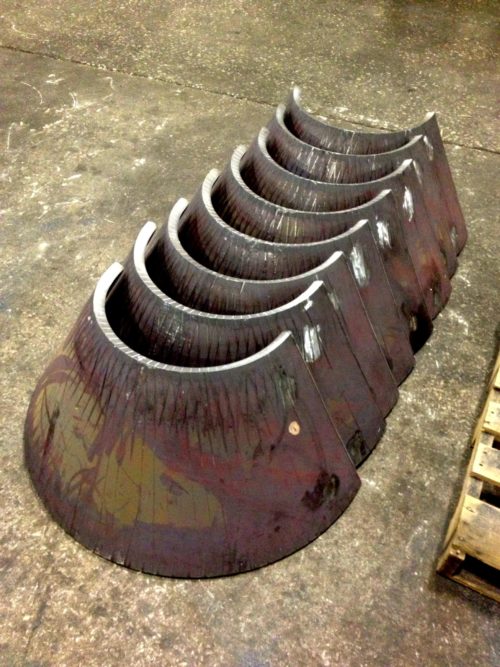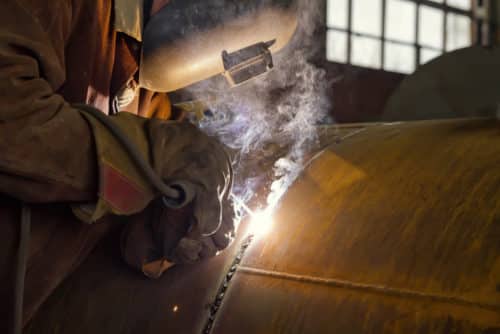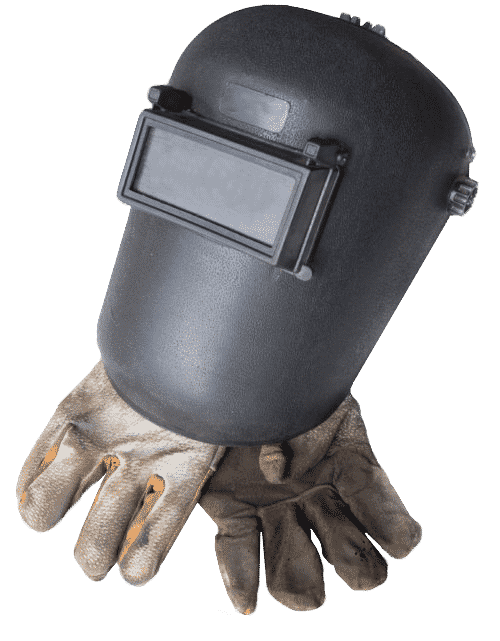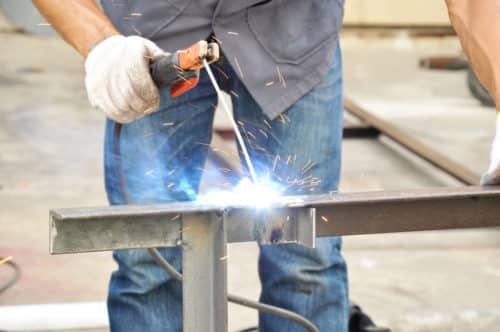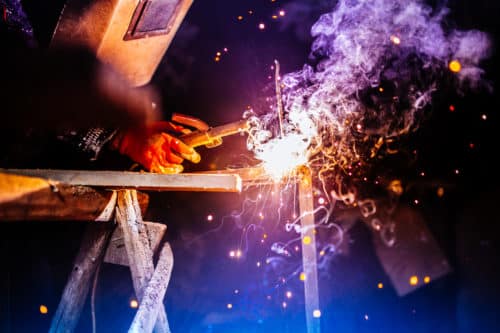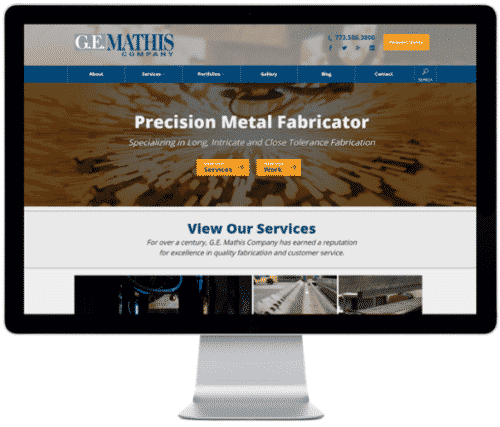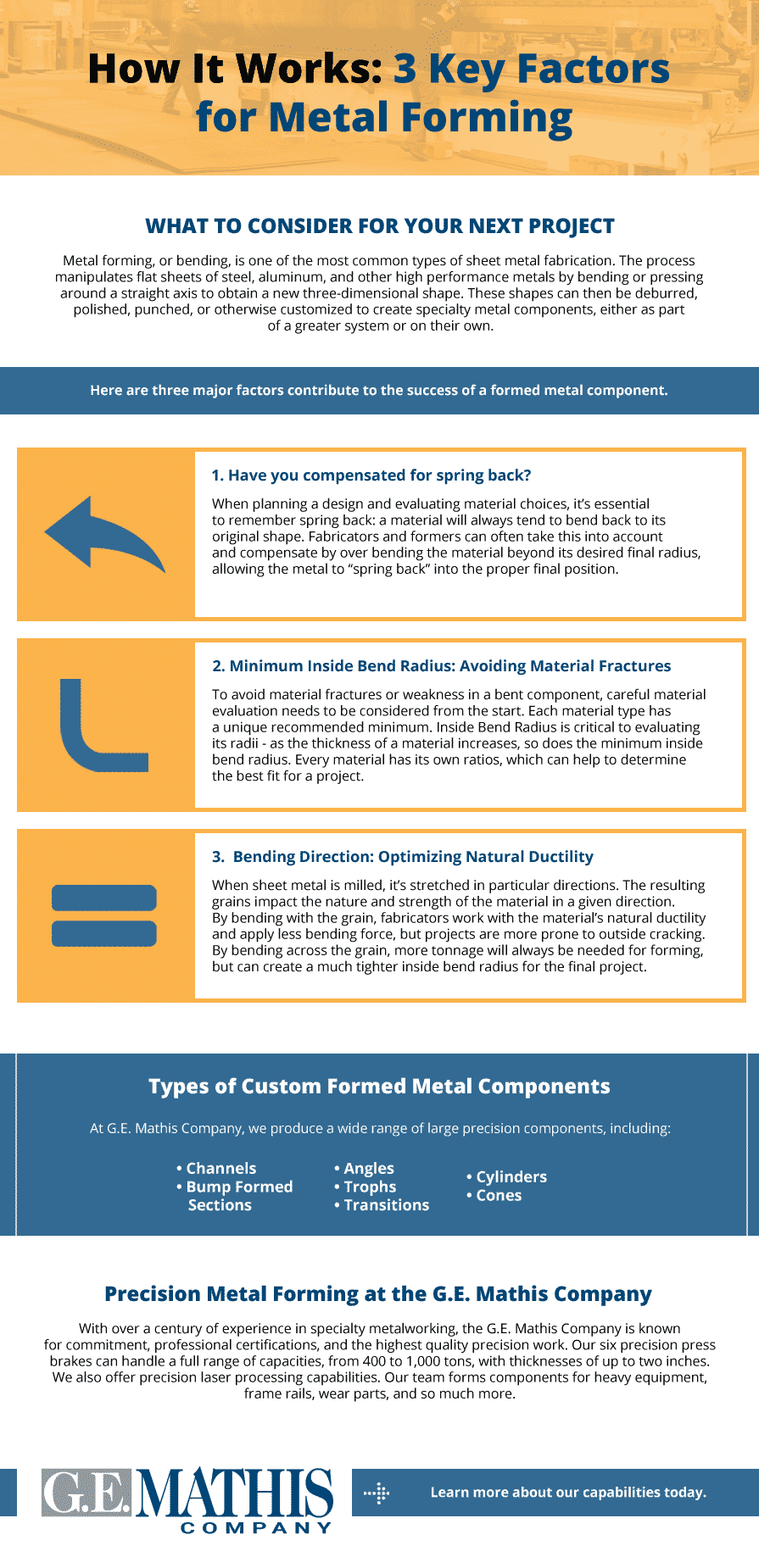All About Metal Fabrication
Metal fabrication refers to the process of cutting, shaping, or molding raw or semi-raw metal materials into an end product. Depending upon the type and grade of metal, as well as the desired end product, metal fabricators may employ a variety of techniques to manufacture cost-effective, high-quality components for a wide range of industrial applications.
Types of Metal Fabrication Processes
Some of the different metalworking methods metal fabricators employ include:
Cutting
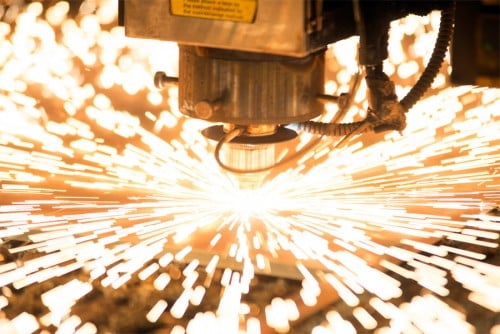
- Sawing is the oldest method of producing straight cuts through metal materials.
- Laser cutting employs a high-powered, focused laser beam of light to cut through the metal materials.
- Waterjet cutting operations utilize a high-powered water stream to cut through different materials, including metal.
- Plasma Cutting uses a mixture of swirling gases to cut through metal.
- Shearing uses two large blades to cut through metal like a giant pair of scissors.
- CNC cutting uses a computer-controlled machine to make precise cuts through metal via a variety of metal cutting techniques (e.g., laser cutting, plasma cutting, etc.)
- Die cutting employs steel rule (flatbed die cutting) or cylindrical (rotary die cutting) dies to cut out precise metal shapes.
Forming/Bending
Unlike cutting, forming (or bending) doesn’t remove material from the metal work-piece. Instead, the process alters the work-piece with a machine such as a press brake, or by a hand-held method such as with a hammer, or die to fit the required specifications.
Welding
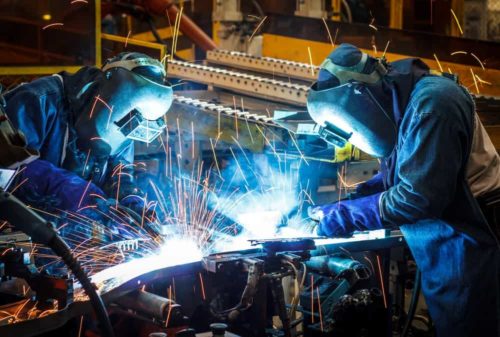
- Submerged arc welding (SAW): This welding method employs a continuous electrode to create an arc between the welding rod and the work-piece. The addition of a thick granular flux forms a shield that protects the weld zone from atmospheric contamination during operations.
- Shielded metal arc welding (SMAW): This welding method—also referred to as stick welding—uses a welding rod coated in flux that carriers a high-power electrical current. The coating breaks down during welding operations, forming a layer of slag and a gas shield that protects the weld as it cools.
- Gas metal arc welding (GMAW): This welding method—also known as MIG welding—relies on an adjustable and continuous solid wire electrode. During operations, the electric arc formed between the work-piece and the electrode heats and melts the base metals to form the weld.
- Gas tungsten arc welding (GTAW): This welding method—also called TIG welding—requires the use of a non-consumable tungsten electrode. It produces strong welds without fillers.
- Fluxed core arc welding (FCAW): This welding method is similar to GMAW welding, except it utilizes a tubular wire electrode filled with flux rather than a solid wire electrode. Self-shielded FCAW operations rely only on flux to protect the weld zone, while dual-shielded FCAW operations rely on both flux and an external shielding gas.
Stamping
Uses a top and bottom die molded into a custom 3-dimensional shape. When the metal is pressed between the two dies, it conforms to the desired shape. This process is used to make many complex metal shapes, such as body panels for the automotive industry.
Machining
Uses CNC-controlled machinery with various cutting tools to rapidly produce a custom 3-dimensional metal component by removing unwanted materials.
Advantages and Applications of Metal Fabrication Processes
There are several different types of metal fabrication processes employed by industry professionals to produce metal parts and products. As each process utilizes different techniques and equipment, it offers distinct advantages and best use cases.
Advantages and Applications of Cutting
Perhaps the most ubiquitous of all metal fabrication processes, cutting can be employed alongside other methods. In general, cutting offers several advantages with more modern techniques providing enhanced manufacturing capabilities. Some of the advantages of using cutting to fabricate metal parts include:
- Greater precision
- Higher repeatability
- Faster production speeds
- Better cost-effectiveness
Advantages and Applications of Forming/Bending
Metal fabricators use forming operations—e.g., rolling, indenting, and bending—to produce many metal parts, such as pipes, enclosures, and boxes. The advantages of using these operations include:
- Broader product capabilities
- Greater part design flexibility, including for complex shapes and geometries
Advantages and Applications of Welding
In general, welding allows for minimal waste production, reduced labor and material costs, and process portability. Each of the individual welding techniques also offers unique benefits. For example:
TIG Welding Benefits
Commonly used for aluminum and aluminum alloys, TIG welding produces a better surface finish than MIG welding and doesn’t require a filler material to produce the weld.
MIG Welding Benefits
Commonly used on steel, MIG welding does require the use of consumable filler material (i.e., the feeding wire). However, compared to TIG welding, it is faster and easier to control.
Sticking Welding Benefits
Commonly used on iron and steel, stick welding is the simplest welding technique. As such, it is used extensively for industrial fabrication applications.
Advantages and Applications of Stamping
Stamped parts are found across a diverse set of industries. The stamping process allows for:
- Higher precision and accuracy
- Faster production speeds
- Lower per-unit production costs (for high-volume runs)
Advantages and Applications of Machining
Machining is a broad industrial term for subtractive manufacturing processes, such as drilling, milling, and turning. While some companies still rely on manual machining units, many companies have adopted the use of computer numerical control (CNC) machining equipment. The latter enables industry professionals to achieve the following:
- Tighter tolerances
- Higher production consistency
- Greater cost-efficiency (for small to medium runs)
Metal Fabrication Solutions From G.E. Mathis Company
At G.E. Mathis Company, we offer industry-leading metal fabrication services to customers across a diverse set of industries. Equipped with a 135,000 square foot, state-of-the-art manufacturing facility and over a century of industry experience, our team provides:
Precision Laser Processing
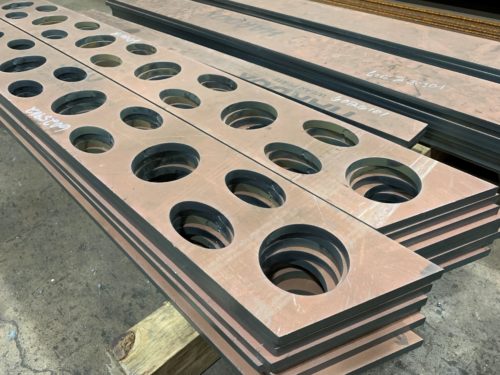
Precision CNC Plasma Cutting
We utilize 4-axis machines capable of high-definition cutting action to provide precision CNC plasma cutting services. The equipment’s 400 amp, straight, dual-head, and contour beveling capabilities help us provide superior results across a wide variety of materials, including carbon, aluminum, stainless steel, and exotic metals.
Precision Forming/Bending
For our precision forming/bending operations, our team utilizes eight hydraulic press brakes, including two equipped with CNC capabilities. These machines feature 400- to 1,000-ton capacities and accommodate thicknesses up to 2 inches and lengths of 20, 20, 30, 23, 25, 40, and 48 feet.
Some of the formed/bent components we fabricate include:
- Cones
- Cylinders
- Ob-rounds
- Segments
- Channels and angles
- Bump formed sections
We process a variety of materials in these operations, such as:
- Carbon steel
- Stainless steel
- Aluminum
- Brass
- Bronze
- Copper
- Titanium
- Hardox® wear plate
Precision Welding
Our AWS-certified welders are capable of providing precision arc and MIG welding services using CNC-controlled welding and fully automated processes, including:
- Dual-wire submerged arc welding
- Flux cored arc welding—i.e., FCAW
- Gas metal arc welding—i.e., GMAW
- Gas tungsten arc welding—i.e., GTAW
- Shielded metal arc welding—i.e., SMAW
- Submerged arc welding—i.e., SAW
We weld materials up to 12 feet wide and 50 feet long, including:
- Carbon steel
- Stainless steel
- Aluminum
- Hardox® wear plate
HARDOX® Wearparts Fabrication
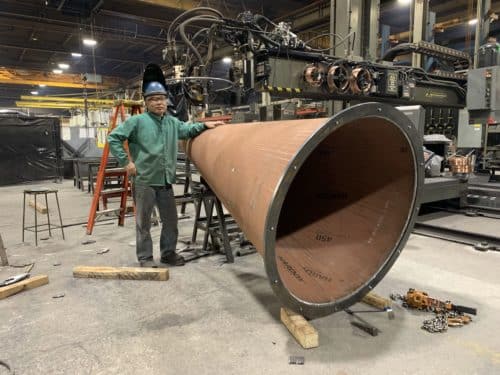
- HARDOX 450
- HARDOX 500
- STRENX 100 (Domex® 100)
- STRENX 110 (Domex® 110)
- STRENX 700
- WELDOX 100
- WELDOX 110
These products are available in up to 2-inch thicknesses with industry-leading tolerances to meet even the most demanding application requirements.
In addition to being an ISO 9001:2015-certified manufacturer, G.E. Mathis Company can provide the following services:
- PPAP (Production Part Approval Process) – All Levels
- FAIR (First Article Inspection Report)
- Capability Studies (Statistical Process Control)
- CMRT (Conflict Minerals Reporting Template)
At G.E. Mathis Company, we have over a century of experience providing metal fabrication solutions. If you have a metal fabrication project, we can meet your needs. Contact us today for more information about our metal fabrication capabilities or request a quote from one of our experts for your next project.
4 Tips for Designing Large, Cost-Effective Components
Large parts are often challenging to fabricate; making cost-effective decisions during the design stage can help to ensure manufacturing success. Sometimes a small change in a design can reduce a project’s cost substantially.
1. Make Things Easy

Easy-to-read drawings take the guesswork out of fabricating. As this is often the only thing that the shop has to work with, it is important to make sure your information is clear, so your manufacturer understands all of the details of the part they are creating.
2. Provide Context
Clearly communicate how you plan to use the final product. Experienced metalworkers will be better equipped to take on your large component fabrication project if they understand the part’s intended use.
All technical drawings and documents should include these details and provide vital information to manufacturers and help them to choose the best equipment for cost-effective fabrication.
3. Be Consistent
Legibility is important, but drawings and prints must also provide consistent and clear information. In-depth data is more important than exact scale drawings and will ensure the best accuracy.
Every drawing should convey the dimensions and tolerances of the product, with clear labeling that identifies all required materials and finishes.
4. Be Conscientious
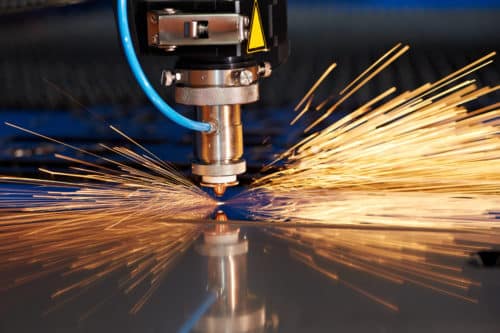
If you’re not sure what processes will be used, like laser cutting, we’ll be happy to talk to you about it. We will gladly work with you towards a solution.
Your Partner in Large Scale Manufacturing
By following these guidelines, your designs will be easily fulfilled to suit all of your application’s requirements. At G.E. Mathis Company, we do our part by maintaining the tooling, equipment, and expertise to complete precision welding fabrication projects of virtually any size.
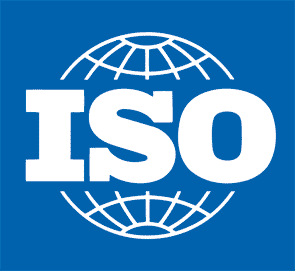
In addition to being an ISO 9001:2015-certified manufacturer, G.E. Mathis Company can provide the following services:
- PPAP (Production Part Approval Process) – All Levels
- FAIR (First Article Inspection Report)
- Capability Studies (Statistical Process Control)
- CMRT (Conflict Minerals Reporting Template)
For further information, contact us today or request a quote for your next project.
The Versatility of HARDOX® Wear Plate
Specifically designed for use in harsh, demanding applications, HARDOX® Wear Plate provides an unmatched combination of hardness and toughness, allowing for extended service life and cost savings. This unique material is used across a wide range of industries to provide optimal reliability and wear resistance.
Why Is HARDOX® So Tough?
HARDOX® Wear Plate is a wear-resistant sheet steel developed by the Swedish company SSAB in 1974. This steel wears slowly, allowing the equipment used in abrasive applications and aggressive-wear environments to last longer, thereby reducing maintenance needs and costs.
HARDOX® offers a unique combination of hardness, strength, and toughness. The material’s high strength enables thinner metal sheets to be used, meaning products can be made to be simpler and lighter while still carrying high payloads. HARDOX® Wear Plate also has good impact resistance, even at low temperatures.
HARDOX® sheets and plates provide ideal welding and machining properties, simplifying production and repair work. To provide this excellent weldability, HARDOX® Wear Plate steel is manufactured to have a highly accurate chemical composition. Advanced hardening and post-treatment processes also help imbue it with its unique properties. The combination of high payloads, low maintenance costs, good availability, and long service life allows for overall cost savings while ensuring optimal reliability.
Finally, HARDOX® provides superior wear performance, crack safety, and deformation resistance provide defense against wear, dents, and cracks. To evaluate these properties, HARDOX® and ordinary high strength structural plates have been compared through comprehensive drop tests; in one test, weights varied between 330 and 1,800 pounds and were dropped from heights of up to 10 feet. The HARDOX® steel plate showed only moderate deformation, while the structural steel alternative couldn’t withstand the impact.
Advantages of HARDOX®
Extremely versatile, HARDOX® provides critical benefits for various industries. Below are some of the key features discussed above.
- Superior hardness — Offering excellent wear resistance, HARDOX® features all-around hardness that doesn’t impact structural performance.
- Excellent toughness — HARDOX® is able to resist cracks if subjected to deformation and can withstand heavy blows, allowing it to be easily bent, formed, and welded. Combined with its high yield strength, this durability also allows for the creation of lightweight designs.
- Consistency — HARDOX® retains its properties and strength even in severe, harsh conditions — and also during precision bending and forming, as well as precision welding and MIG welding — allowing for predictable, reliable results.
- Long service life — HARDOX® can double, or even triple, equipment wear plate service life, optimizing performance while minimizing the risk of damage.
Common HARDOX® Applications
HARDOX® unique properties make it well suited to a wide range of industries and applications, such as:
- Construction and demolition — HARDOX® can be used in various types of construction equipment, from evacuators and demolition tools to fragmentizers, all of which require high reliability and longevity to withstand heavy use and ensure worker safety.
- Mining — In this safety-critical industry, worker’s equipment — such as mining trucks — must be able to stand up to harsh conditions while maintaining a long lifespan; HARDOX® provides this reliability, cutting down on repair costs and delays.
- Military — HARDOX® Wear Plate provides the protective strength and reliability required in the military industry and is commonly used in the manufacture of armored vehicles.
STRENX® (Domex® ): High Performance, High Strength Steel
What Is STRENX®?
STRENX® is a High Strength, hot-rolled steel sheet also offered by SSAB; the steel is low-alloy and cold-formed. Previously called Domex, this unique material has been rebranded as STRENX.
The Advantages of STRENX®
Extremely versatile, STRENX® provides critical advantages for various industries. Some of its unique qualities and benefits include:
- Excellent versatility — This steel has excellent formability and good weldability, meaning it can undergo various manufacturing processes.
- Reduced production costs — Strenx allows for the manufacture of stronger, higher-quality products that require less steel and welding. This also allows for a lighter-weight product less susceptible to damage, saving money on repair and replacement costs in the long run.
Common STRENX® (Domex) Applications
The unique properties of STRENX® make it well-suited to a wide range of industries and applications, such as:
- Automotive — Designers like to keep structural weight low but strength-handling levels high. With Strenx, products made can be simpler and lighter while still carrying higher payloads.
- Construction and demolition — Strenx can be used in cranes and booms, both of which require high reliability and longevity to withstand heavy use and ensure optimal worker safety.
Learn More
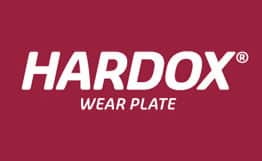
To learn more about the uses and unique properties of HARDOX® — which is ideal for a wide range of fabrication methods, including welding, cutting, bending, and bending — download our free eBook, “Fabricating Tougher Components with HARDOX® Wearparts.”
Understanding Different Types of Welding
An extremely versatile fabrication process, welding is used in nearly every industry, from agriculture and mining to construction and aerospace. Over the years, specialized welding techniques have been developed to better suit the needs of specific industry challenges, whether they involve fusing dissimilar metals or custom fabricating parts for critical-use applications.
To determine which type of welding is best suited for a specific project, welders must consider the physical properties of the workpiece and filler material, desired product specifications, necessary equipment and power supplies, and the customer’s timeframe.
Let’s look at some of today’s most widely used welding methods and how they differ:
Types of Welding
Submerged Arc Welding
Requiring a continuous electrode feed to create an arc between a welding rod and the workpiece, this type of welding adds a thick granular flux to form a shield. The result is a flux blanket, under which the arc is submerged to protect the weld zone from atmospheric contamination. This process can be automated, mechanized, or semi-automated through the use of hand-held guns.
Shielded Metal Arc Welding (SMAW)
Commonly referred to as “stick” welding, shielded metal arc welding (SMAW) is an inexpensive, manual process requiring a welding rod coated in flux, which carries a high-power electric current. During welding, the electrode’s flux coating breaks down, creating a layer of slag as well as a gas shield to protect the weld until it cools. Final products may require finishing services, however, as molten splatter is a common occurrence.
Gas Metal Arc Welding (GMAW)
Gas metal arc welding, also called MIG (metal inert gas) welding, is distinct in its use of an adjustable, continuous solid wire electrode feed. Versatile and easily automated, GMAW only requires that the welder guides the welding gun in the proper position and orientation along the fusion point. The electric arc formed between the electrode and the workpiece heats and melts the metals to join them.
Flux Core Arc Welding (FCAW)
Similar to MIG welding, flux core arc welding uses a tubular wire filled with flux in place of a solid wire. Dual-shielded FCAW uses the flux with an external shielding gas for protection, while self-shielded FCAW relies only on flux to protect the molten weld puddle, making this an ideal option for outdoor applications. As an automated process, FCAW is also popular for projects requiring quick turnaround times.
Gas Tungsten Arc Welding (GTAW)
Gas tungsten arc welding, more commonly referred to as TIG (tungsten inert gas) welding, uses a non-consumable tungsten welding rod (or electrode) to apply intense heat to the base metal. This produces an autogenous weld by melting two pieces of metal directly together without a filler. TIG welds are also protected by an external shielding gas — usually argon. This method produces strong, high-quality welds, though the process can be painstaking, requiring extreme focus and precision to weld the small space between the arc and the workpiece.
Specialty Welding at G.E. Mathis Company
At G.E. Mathis Company, our experienced, skilled team of sheet metal welders is certified to AWS D1.1, D1.6, D9.1, and D10.9 standards. We work regularly with carbon steel, stainless steel, and HARDOX® Wearplate.
In addition to being an ISO 9001:2015-certified manufacturer, G.E. Mathis Company can provide the following services:
- PPAP (Production Part Approval Process) – All Levels
- FAIR (First Article Inspection Report)
- Capability Studies (Statistical Process Control)
- CMRT (Conflict Minerals Reporting Template)
To learn more about specialty welding, or to discuss how our team of experts can help with your next project, contact us today.
New Website for G.E. Mathis Company
G.E. Mathis Company recently launched a new website. This new site is completely redesigned from top to bottom. In addition to easier access and a totally new design, what else can you expect when you visit G.E. Mathis Company’s brand new website?
Here’s an overview of the latest updates:
1. Improved accessibility
Our new drop-down navigation menu makes it easier to browse our valuable resources and company information. The navigation menu is conveniently located at the top of each page. Users can easily access our services, industries, case studies, photo gallery, and more.
2. More user-friendly experience
With over a century’s worth of experience, we at G.E. Mathis Company pride ourselves on delivering quality services and capabilities to our customers. With that in mind, we’ve ensured that our new website offers the best possible user experience. We’ve achieved this goal by implementing a completely new and more appealing design. We have also given the site a responsive design. This makes it simple to access our site on any desktop, tablet or mobile device.
3. Enhanced information
We know when users visit a website, they want to find relevant information quickly and easily. Our new website highlights past projects we’ve successfully completed by showcasing them in our portfolios. These feature jobs in laser cutting, forming, plasma cutting, and welding. We also provide the most up-to-date information on all of the services we offer, including:
- Laser Processing
- High-Def CNC Plasma Cutting
- Precision Forming/Bending
- Welding
- HARDOX® Wearparts Fabrication
In addition to being an ISO 9001:2015-certified manufacturer, G.E. Mathis Company can provide the following services:
- PPAP (Production Part Approval Process) – All Levels
- FAIR (First Article Inspection Report)
- Capability Studies (Statistical Process Control)
- CMRT (Conflict Minerals Reporting Template)
We encourage you to browse our new website today to learn more about the intricate and close-tolerance fabrication services we provide. These cover a vast range of industries from construction, agricultural, chemical, defense, mining, trailers/truck bodies, contract manufacturing, and much more. You can also always request a quote, or contact us with any questions or learn how we can assist you with your next project.
Three Large-Scale Metal Components You Didn’t Know We Fabricated
G.E. Mathis Company began as a one-man operation in 1905. Since then, we have grown to occupy a 135,000 square foot facility in Chicago, IL, providing fabrication services using state-of-the-art technology. While we started small, our dedication to providing oversized components is recognized today throughout the industry.
Demanding industries rely on our knowledge, expertise, and fabrication skill to create large-scale, intricate fabrications at close tolerances. Our work encompasses jobs at every level of complexity and size.
Whether we are constructing custom roll-formed cylinders, a custom-welded boom-tube, or performing architectural laser cutting of stainless steel panels, G.E. Mathis Company construction projects are virtually limitless:
· Precision Laser-cut Architectural Panels
Our shop produced a set of intricate precision laser cut large panels. We cut each panel from A240-T304 stainless steel with our 6,000-watt laser, advancing from raw materials to fully finished, ready-to-install panels in just two weeks.
The final 91 individual architectural laser cut panels measured 0.25” thick by 63” wide by 163” tall, all of which now adorn a stunning outdoor installation.
· Rolled Cylinder Segments
Petroleum tanks require some of the industry’s largest fabrications. We partnered with an oil industry client to produce premium quality rolled steel cylinders for a tank assembly. Working from a customer-supplied print, we rolled 0.375” thick 304 stainless steel plates through our variable geometry 3-roll pinch-type plate rolling machine to produce 32 rolled segments.
After rolling, each cylinder section had a 300” interior radius through 45° and was 96” long. All 32 rolled segments arrived at their final destination within three weeks.
· Custom-welded Crane Boom
Cranes are essential for moving large-scale components; building them requires heavy-duty welded rectangular tubes. Our client needed a custom boom tube section for an enormous crane. Utilizing our submerged arc seam welder, we welded STRENX® (Domex) 100XF channels into rectangular tubes that measured ¼” thick by 18” by 20” by 240” long. After welding, we inspected each piece, and delivered them within a three week timeframe.
These pieces were noteworthy for their exceptional accuracy. Our skilled welders produced 50 of these welded boom-tubes at tolerances of ±0.125” and better.
Custom Solutions from GE Mathis
The examples above are just a sample of our precision custom products. At G.E. Mathis Company, we provide custom large-scale manufacturing for virtually every industry, including:
- Agricultural
- Architectural
- Chemical
- Construction
- Defense
- Energy
- Marine
- Mining
- Trailer / Truck body
- Contract manufacturing
- High-quality components
For more information about these projects, please see our portfolio gallery or contact one of our representatives directly today.
How It Works: 3 Key Factors for Metal Forming
What to Consider for Your Next Project
Metal forming, or bending, is one of the most common types of metal fabrication. The process manipulates flat sheets of steel, aluminum, and other high performance metals by bending or pressing around a straight axis to obtain a new three-dimensional shape. These shapes can then be deburred, polished, or otherwise customized to create specialty metal components, either as part of a greater system or on their own.
Here are three major factors contribute to the success of a formed metal component.
1. Have you compensated for spring back?
When planning a design and evaluating material choices, it’s essential to remember spring back: a material will always tend to bend back to its original shape. Fabricators can often take this into account and compensate by over bending the material beyond its desired final radius, allowing the metal to “spring back” into the proper final position.
2. Minimum Inside Bend Radius: Avoiding Material Fractures
To avoid material fractures or weakness in a bent component, careful material evaluation needs to be considered from the start. Each material type has a unique recommended minimum. Inside Bend Radius is critical to evaluating its radii — as the thickness of a material increases, so does the minimum inside bend radius. Every material has its own ratios, which can help to determine the best fit for a project.
3. Bending Direction: Optimizing Natural Ductility
When sheet metal is milled, it’s stretched in particular directions. The resulting grains impact the nature and strength of the material in a given direction, so be sure to note whether a sheet is being formed with (longitudinally) or across the grain.
By bending with the grain, fabricators work with the material’s natural ductility and apply less bending force, but projects are more prone to outside cracking. By bending across the grain, more tonnage will always be needed for forming, but can create a much tighter inside bend radius for the final project.
Types of Custom Formed Metal Components
Metal forming specialists craft the critical components needed to support almost every industry — aerospace, military, automotive, medical, food service, manufacturing, communications — the list goes on and on. At G.E. Mathis Company, we produce a wide range of large precision components, including:
- Channels
- Angles
- Formed Pan sections
- Transition segments
- Bump Formed Sections
- Cones
Precision Metal Forming at the G.E. Mathis Company
With over a century of experience in specialty metalworking, the G.E. Mathis Company is known for commitment, professional certifications, and the highest quality precision work. Our eight precision press brakes can handle a full range of capacities, from 400 to 1,000 tons, with thicknesses of up to two inches. We offer metal fabrication beyond bending and forming, too — precision laser processing, plasma cutting, and welding are a few of our capabilities.
Our team forms components for heavy equipment, frame rails, wear parts, and so much more. Contact us to discuss your next project with one of our metal forming professionals or learn more about our capabilities today.
American Manufacturing in 2014 and the Outlook for 2015
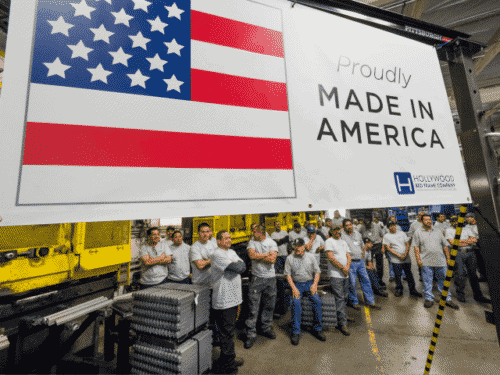
Pundits are attributing this ‘revival’ of US manufacturing to three main reasons:
- Because of the sophistication of the fracking process, the US is now the largest producer of oil and natural gas in the world, trumping Saudi Arabia to claim the elusive title. The implications of this feat are profound leading to a significant drop in transportation as well as electric costs within the country.
- Because of the innovations in the field of robotics, the rote work of wrench turning has now been delegated to industrial robots and other precision instruments. The main issue with labor in the US was availability of reliable and competent blue collar workers for the minimum wage rate. Thanks to the automation of certain processes, human ingenuity and logic can be better rewarded with higher paying jobs of supervisors and managers.
- United States can now boast very low cost of raw materials leading to a dip in overall manufacturing investment as well.
The US manufacturing sector alone is the 8th largest economy in the world, and this trend is likely to sustain in 2015 and even beyond.
The main focus of the coming years is going to be the Re-shoring vs. Offshoring battle. The global labor pool has become more aware of its rights, and the cry of improved wages is resonating from all corners of the world. Pay has risen by a significant 10% in China and were likely to spread to other countries as well.
Most probably the industries which are not labor intensive and suffer from the often prohibitive costs of long transportation routes (like chemicals and metals) will move back to home soil in order to take advantage of the boom in oil production and the easily available rich reserves of raw materials.
Ventures with high foreign demand and the pressing need for a lot of affordable labor to keep production running will continue to go the offshore way, especially if the manufacturing skill gap is not remedied.
The future of US Manufacturing is bright! But only time can shed light on the dominant trends which will re-shape the sector for the coming decades.
Our Metal Forming Skills are a Work of Art
Throughout the manufacturing industry, there has been a lot of discussion around what is known as the “skills gap.” The skills gap –essentially the lack of workers with appropriate skills for the industry—is becoming more of a problem as the baby boomer generation is beginning to retire and the younger workforce are finding careers in other fields. Not only is the skills gap affecting the bottom line, but’s it’s also providing manufacturers with a major challenge.[1]
Here at G.E. Mathis Company, we understand the importance of these technical skills, as they allow our craftsmen to perform at the highest levels. Take, for example, our forming capabilities. Our advanced equipment and expertise allow us to process metal in a variety of dimensions and shapes, even up to 2” thick. Taking our forming services to the next level, we can bend long parts up to 48 ft. long.
Forming metal is an art, a skill acquired through observation and instruction. It is a skill that needs the human touch, one that cannot be completed by a robot or machine. Our skilled craftsmen pride themselves on their ability to form almost any shape. Some of the special shapes that we form, such as cone segments, cannot be processed through automation; instead, the operator needs to form the radiuses in the component using our unique equipment, working the metal blank to form the shape to the customer’s specifications. There is a complex process that we go through to form these complex parts.
This process requires a lot of technical skill, something that is becoming more and more unique, as we have seen due to the skills gap. However, our shop team continues to put this high level of skill into each part that they make, no matter what the customer’s specifications are. In fact, two recent projects we worked on exemplify the type of skill needed for metal forming: eccentric cones and elbow transitions.
Eccentric Cones
Unlike more traditional concentric cones, where the center points of each end of the cone are the same, the eccentric cones have these center points offset.
Elbow Transitions
Elbow transitions are used where a pipe needs to make a turn in an assembly. These also require a very specific and high level of skill to be able to fabricate and fit together with precision.
Neither of these projects had straight-forward dimensions, nor could they simply be made by an automated machine. Instead, they required specific radiuses that needed to be formed by a skillful hand. Rising to the challenge, our craftsmen have the skills to do so. G.E. Mathis Company will assure that these skills never become a lost art.
[1] http://www.sandiegonewsroom.com/business-finance/1282-how-to-combat-the-manufacturing-skills-gap
Bridging the Way through Manufacturing’s Skills Gap
As a long-time American manufacturer, we have seen manufacturing rise and fall, as well as rapidly change due to up-and-coming technologies. Today, we certainly see how American manufacturing is experiencing a renaissance, due to re-shoring and new technology that has been introduced into the production process. However, there is one looming issue that is poised to greatly affect manufacturing’s success—that would be the skills gap.

Manufacturing companies throughout America are finding a variety of ways to rectify this issue. For example, there are some local schools that are trying to start STEM programs, giving young students a solid background in science, technology, engineering, and math fields. The City of Chicago is partnering with Chicago Public Schools and other organizations to offer an education focused on technology and sciences, ensuring that students are prepared for future careers in STEM fields.
While the skills gap is a problem for the manufacturing industry, educational organizations and many companies are working tirelessly to prepare young workers for our modern, technical, and challenging workforce. We encourage younger generations to realize the skills and opportunity that lie in a manufacturing career, and we hope to see you on the production floor soon!






